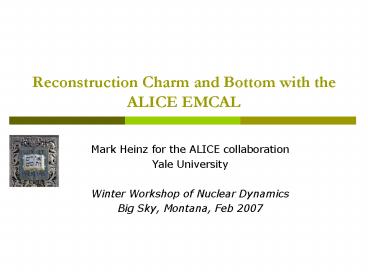Reconstruction Charm and Bottom with the ALICE EMCAL - PowerPoint PPT Presentation
1 / 22
Title:
Reconstruction Charm and Bottom with the ALICE EMCAL
Description:
Method for reconstructing Bottom via displaced vertices. ALICE Electromagnetic Calorimeter ... Lead-scintillator sampling calorimeter. Shashlik fiber geometry ... – PowerPoint PPT presentation
Number of Views:40
Avg rating:3.0/5.0
Title: Reconstruction Charm and Bottom with the ALICE EMCAL
1
Reconstruction Charm and Bottom with the ALICE
EMCAL
- Mark Heinz for the ALICE collaboration
- Yale University
- Winter Workshop of Nuclear Dynamics
- Big Sky, Montana, Feb 2007
2
Outline
- Physics Motivation
- Method for reconstructing Bottom via displaced
vertices - ALICE Electromagnetic Calorimeter
- EMCAL simulation status
- Conclusion
3
Physics Motivation
- Current theoretical estimates for bottom and
charm production still have large uncertainties.
NLO pQCD, pp, ?s 14 TeV
CERN/LHCC 2005-014, hep-ph/0601164
MNR code Mangano, Nason, Ridolfi, NPB373 (1992)
295.
4
Physics Motivation
STAR, submitted to PRL (nucl-ex/0607012)
- Heavy ion collisions
- Interactions of heavy quarks with the medium
- RHIC has recently shown the that the suppression
of non-photonic electrons is not consistent with
current energy loss predictions - Using the current best estimates for medium
density (q-hat) the suppression pattern is
consistent with charm quarks only up to 8 GeV/c
in pT - Similar uncertainties are present for LHC energies
5
Charm and Bottom via semi-leptonic decays
- Semileptonic Channels
- c ? e anything (B.R. 9.6)
- D0 ? e anything (B.R. 6.87)
- D? ? e? anything (B.R. 17.2)
- b ? e anything (B.R. 10.9)
- B? ? e? anything (B.R. 10.2)
- ? single non-photonic electron continuum
- Photonic Single Electron Background
- g conversions (p0 ? gg)
- p0, h, h Dalitz decays
- r, f, decays (negligible)
- Ke3 decays (neglible)
6
Displaced Vertex Method
- Search for semi-leptonic B-decay
- B ? e D0 ? e K- ?/e
- Idea of Displaced vertex finding using muons was
first tested at CDF - Create pairs of leptons and charged tracks which
match the criteria for a secondary vertex - pTgt 2 GeV/c, R???2??2
PeK
e-
D0
SecVtx
r
Reminder B ct 500 mm D ct 100 mm
B-
PrimVtx
7
Displaced Vertex Simulations (signal)
- 1st Step pure signal ? efficiency
- PYTHIA 14 TeV, pp, 40k events, pt(hard)gt2.75
- Yields 6000 electrons within detector acceptance
from beauty - Reconstruction efficiency per selected electron
trigger 70
Signal
Lxy (cm)
8
Displaced Vertex (charm backgrounds)
- Dominant backgrounds are semi-leptonic charm
decays - Simulation PYTHIA, 14 TeV pp, c-cbar,
pt(hard)gt2.1 GeV - Effective way of eliminating is by cut on
invariant mass
9
Displaced vertex (backgrounds)
- 80k Minbias PYTHIA events (MSEL1)
- Combinatoric, pi0 and photon backgrounds can be
investigated - Background is consistent with zero, but more
simulation statistics are needed to obtain an
exact estimate of significance
Minbias PYTHIA, 14 TeV
Minbias PYTHIA, 14 TeV
10
Track impact parameter resolution
- Primary vertex finding proceeds in 2 passes
- Select primary tracks on the basis of their d0
- Cut d0 lt n?sd0(pt)
- sd0(pt) svtx ? strack(pt)
11
Secondary vertex resolution (simulation)
- Determine position resolution for semi-leptonic
heavy flavor vertices from PYTHIA - Position resolution in x,y,z is 180mm, no strong
dependency on coordinate
?/e
K
SecVtx
reconstruced- MC (cm)
reconstruced- MC (cm)
reconstruced- MC (cm)
12
Secondary vertex resolution (simulation)
- Study of vertex resolution as a function of hits
in the inner tracker ITS-hits, maximum of 6 hits.
13
ALICE Set-up
Size 16 x 26 meters Weight 10,000 tons
TRD
ITS
TPC
14
ALICE Electromagnetic Calorimeter
Lead-scintillator sampling calorimeter Shashlik
fiber geometry Avalanche photodiode readout
Coverage hlt0.7, Df110o
15
ALICE EMCAL (2)
Supermodule
- 12 supermodules
- 24 strips in ?
- 12 (or 6) modules in f
- 12672 elementary sensors (towers)
- 77 alternating layers of
- 1.44 mm Pb (1 Sb)
- 1.76 mm polystirene scintillator
- Dh x Df 0.014x0.014
Module (2x2 towers)
16
EMCAL energy resolution
- Energy resolution has been measured and is within
specifications 12/?E 2
Production Module Spec
Prototype Module Spec
17
EMCAL Project milestones
- 18 institutions worldwide of which 13 are from
ALICE-USA collaboration - Assembly of supermodules will be shared between
Yale (US) and Grenoble (F) - US-portion of project dependant on funding from
DOE CD-2 (critical decision) this summer. - Assembly and testing of supermodules (SM) at Yale
to start in 2008 - Installation of first SM in 2009 (low luminosity
PbPb)
18
EMCAL software development
- Cluster shape analysis for PID
- Electron/Hadron discrimination
- Track-Cluster Matching
- Electron trigger simulations
- High-Pt simulations (jet-finder)
- Institutes involved in HF simulations
- Yale, LBL, LLNL, WSU, Nantes (Subatech),
Strassbourg, Catania
19
EMCAL PID
- e/p? discrimination
- p/E distribution
- g/p0 discrimination
- Cluster shape analysis
- Effective mass
20
Hadron/p0 discrimination
- Granularity study of EMCAL
Granularity 2x2
Granularity 3x3
For a 30 GeV photon the ?0 suppression factor
improve from 10 to 100 when increasing the
granularity from 2x2 to 3x3
Study by A.Pavlinov (WSU)
21
TPC track to EMCAL cluster matching
- Code is now in Alice CVS
- Good matching effiency for low multiplicity
- Still some parameter tuning needed for Hijing
simulations
Cluster Matching Prob for electrons
Mult 10
Study by A.Pulvirenti (Catania)
22
Conclusion
- Displaced vertex method will be promising in
measuring direct B-meson contribution to
non-photonic electrons - The method combines the EMCAL PID and triggering
capabilities - The ALICE EMCAL project is a collaboration
between ALICE USA and European institutions - The simulations for the EMCAL are on track,
however more detailed physics simulations are
required for the DOE CD-2 decision this summer































